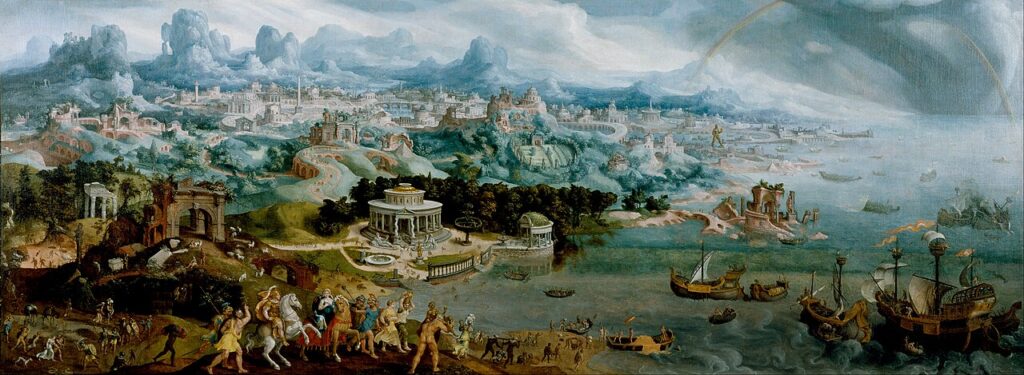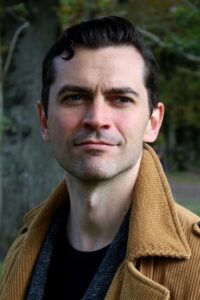by Samuel Miller McDonald
Samuel Miller McDonald’s book, Progress: How One Idea Built Civilization and Now Threatens to Destroy It, offers a bold, provocative, wide-ranging argument about the human idea of progress. Below, McDonald particularly focuses on progress during the rise of “civilization” on earth (the Holocene period) and its subsequent effects on the planet.
Six years ago, the observatory in Hawaii that tracks atmospheric gases recorded more carbon dioxide than the atmosphere has contained in 800,000 years: 415 parts per million. On November 9, 2025, the day before I wrote this sentence (and the most up-to-date measurement available), it was 426 ppm. For context, human beings likely evolved sometime between 300,000 and 400,000 years ago. In that time, carbon dioxide never breached 300 ppm. Large-scale agriculture was likely developed around 10,000 years ago. What we call “civilization,” primarily consisting of market empires, emerged only 5,000 years ago. Most geologists agree that agriculture and civilization belong in an epoch of planetary history known as the Holocene. As a result of the rise in carbon dioxide from fossil energy (and other planetary changes), we are now in a different geological epoch.

Some people think that this current iteration of civilization has freed human beings from the earth’s climate, as if society were impervious to weather. But the fact is, there is no society that doesn’t need pollinators, like birds, bats, and bees. There is no society that can get by in a world without trees or a living ocean, or clouds. Society is not, and won’t ever be, free from the climate or the broader environment, and we simply don’t know how civilization will respond to this new planet. We do know that, in the past, civilizations have been very sensitive to fluctuations in climates, particularly as they affect food supply. Human beings can’t live without food, and societies that do not provide food don’t last long, dying either by starvation or civil war. We know that, today, in the twenty-first century, crops still fail due to the weather. We know that governments are overturned when food prices spike.
Given the challenges of this new world, we have to think seriously about what post-Holocene progress might look like. We can’t take for granted that the current trajectory of society will generally continue, and because this change in the fundamental nature of the planet is unprecedented in human history, we can’t take the narratives of progress bequeathed from historical thinkers for granted either. After all, they have all been constructed in and for the human systems native to the Holocene and the “civilized world” of the last 5,000 years.
Of course, the image of the ideal society that emerges in this new epoch will be remade every day. We at the beginning cannot hope to construct something that will endure the hardships, or anticipate the joys, that will exist in that world to come. Nevertheless, one great task is to set the magnetic north of progress so that those people and animals and plants who inhabit the next 5,000 years may still survive and enjoy thriving forests, ocean life, and a livable atmosphere.
There are some truths we must accept in imagining this post-Holocene progress. For one, we cannot assume an ever-increasing energy expenditure, given that this is the prime material cause for this new epoch: fossil energy use must stop and everything dependent on it must be abolished or reformed. There can’t be 1 billion personal vehicles nor the roads that carry them; there can’t be sprawling data centers; there can’t be huge concentrated animal feeding operations; there can’t be trillionaires (nor, hopefully, billionaires or millionaires); and much else. We must also assume a certain amount of retreat of human impact on the world. We are currently testing the limits of how much non-human life can be destroyed before there’s a total collapse of life systems. Anything that resembles progress, then, must halt and reverse this process, and open the scope for non-human life to flourish, whether in cities, farmed zones, suburban areas, or in wild habitat.
In the past 5,000 years, most human beings who lived and died did so in inescapable servitude, slaves or near-slaves to almost-untouchable masters. This includes today, a time in which there are more enslaved people than there were at the height of the Atlantic slave trade. Unless there is a significant change in how human beings relate to one another, and the level and kind of dignity most people claim as a natural right, it is likely that the next 5,000 years will have just as great a proportion of enslaved people as the last 5,000 did, or maybe even greater. Post-Holocene progress, then, must entail not merely sustaining some legal precedent for the abolition of slavery, nor even just a greater legal emancipation than exists currently, but the total dismantling of all infrastructures and social structures capable of controlling populations, whether they’re AI-piloted microdrones or the lowly fetters, whether conditional suffrage or the corporate bureaucracy, ideological faith or religious faith.
My book, Progress: How One Idea Built Civilization and Now Threatens to Destroy It, traces the ideas that have entrapped and enslaved people, and their source in progress. It goes beyond arguing for what must be destroyed or abandoned and provides a broad discussion of how individual agency can align with collective action to bring about positive changes into the coming centuries. It’s not just about mitigating harms, but also about turning the turmoil of the twenty-first and -second centuries toward improvement: creating something new and better in the vacuums of possibility prised open by chaos.
Yet we also must refrain from imposing some rigid regime on the future. It’s obvious the world cannot, and should not, sustain market empires and their current organizing system, capitalism. It’s not clear what system for maximizing human and animal flourishing will be best fit for the coming millennia, if any can. For navigating the post-Holocene, we should follow the instruction of those societies that thrived through the vicissitudes of the 300,000 years of human life in the pre-Holocene. But that, too, will only take us so far, since we now live in a fundamentally different world. We may not know what progress will or should mean in distant millennia, but we know what it can’t mean: more of this.

SAMUEL MILLER MCDONALD is a geographer focusing on human-ecology, theory, and history. He holds a doctorate from Brasenose College, University of Oxford and degrees from Yale University and College of the Atlantic. He has written essays and analysis for The Nation, The Guardian, The New Republic, Current Affairs, Boston Review, and elsewhere, and has contributed interviews to BBC Ideas, VICE News Tonight, and various radio and podcast programs. Progress is his first book.